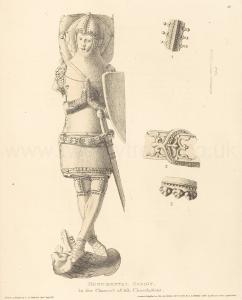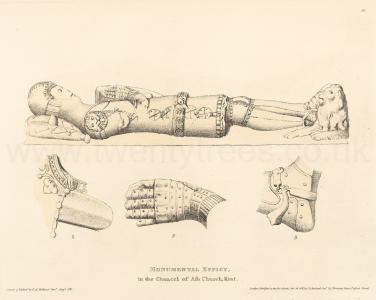Sabatons
Sabatons is in Armour.
Sabatons. Sabatons are articulated armour of the feet typically worn by mounted knights.
Effigy of Aymer de Valence, Earl of Pembroke. AYMER DE VALENCE was the third and youngest son of William de Valence, whose effigy has already been described, and by the death of his brothers during his father's life-time, succeeded him in the Earldom of Pembroke. He was much employed in military service by his kinsman Edward I. particularly in his Scottish wars. That King going into France in 1286 left him Regent of the Realm. In 1305 he was appointed Keeper of the Marches of Scotland about Berwick, and Commander of the Forces sent to oppose Robert Bruce, Earl of Carrick. He was present with King Edward at the time of his death at Burgh upon the Sands [Note. Burgh by Sands, Cumberland is in Cumberland being on the west coast] in Northumberland, who requested him to protect his son from the contamination of the debauched foreigner Gavaston. He united with the Barons against that minion of the second Edward, besieged and took him prisoner in Scarborough Castle [Map]. According to the capitulation Gavaston was to have been allowed to have an interview with the King, and to be tried by his Peers; but the Earl of Warwick took the profligate Gascon from de Valence's custody, and summarily beheaded him on Blacklow Hill, near Warwick. In 1314 the Earl of Pembroke was present at the battle of Bannockburn, so disastrous to the English arms in Scotland. He is said to have met his death in France at a tournament, which was appointed by himself in order to celebrate his marriage with his third wife Mary (age 22), daughter of Guy de Chastillon, Earl of St. Pol. She founded Pembroke Hall, in the University of Cambridge. Aymer de Valence was buried on the North side of the Choir of the Abbey Church at Westminster [Map], and his tomb is celebrated for its architecture and sculptural decorations. In the trefoil ornament which fills up the pediment on either side the monument he is represented on his barded horse. The compartments round the altar slab, on which his effigy reposes, are occupied by elegant statues representing his friends and connexions, and decorated with escutcheons of their arms.


Details. Plate 1. 1. Figures at the head of the Effigy. 2. Band or lace of the hood. 3. Band confining thesurcoat to the waist. 4. Sword belt. Effigy as originally painted: Plate If. 1. Toe of the solerette of the figure on horseback. Figure on horseback, North side of the tomb; basnet, aventaille, mantelet, surcoat, &c. Bases of the barded horse, bearing the bars and martlets of De Valence. 3. Figure on the North side of the tomb.
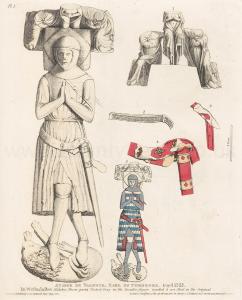
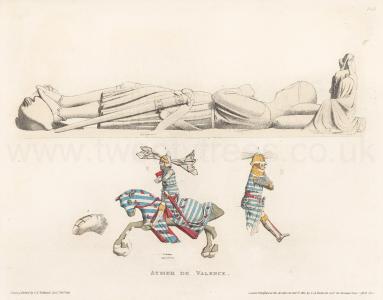
Effigy of John of Eltham, Earl of Cornwall. John of Eltham 1st Earl Cornwall
WAS the second son of Edward the Second by his Queen Isabella (age 42), and was horn at the Palace of the English Kings at Eltham in Kent [Map], on the Feast of the Blessed Virgin's Assumption 1316. In the second year of the reign of his elder brother, Edward III (age 24) he was created Earl of Cornwall. In the following year, the King going to France to do homage for the Dukedom of Aquitaine, he was appointed his Lieutenant for the Kingdom, as he was also on the King's expedition into Scotland in 1330. In the course of the above periods he had grants of numerous Lordships from the Crowna, the town of Lostwithiel (in the neighbourhood of Restormel Castle, the principal seat of the Earls of Cornwall in the County), all the wreck, port dues, issues, and profits of the district, the farm of the City of Exeter, the stannaries, and coinage or customs on stamping the tin in the County of Devon. In 1333 and 1334 he was with King Edward III in his expeditions into Scotland, and died at Berwick-upon-Tweed [Map] in October of the latter year. About the festival of Christmas, the King, with the Archbishop of Canterbury, returned out of Scotland to celebrate his obsequies in the Abbey Church of Westminster, where he was interred on the south side of the Choir. The Prior and Convent claimed £400 in lieu of his horse and armour, which, according to the custom, should have been presented as an offering at the altar of their Church. John of Eltham was but twenty-eight years of age at his death, and was never married. Various matches were proposed for him, as with Joan, the daughter of the Earl of Eu; Mary, the daughter of the Earl of Blois; Mary (age 18), daughter of Ferdinand Lord Lara in Castile, which last proposal came to a formal contract, rendered abortive bv his demise.


Nothing can be finer in its way than the sculpture of this effigy. There is no departure from the very usual recumbent attitude, the hands raised in prayer and the legs crossed; but there is a most beautiful simplicity in the whole figure, while the details of the arms and drapery are marked with elegant precision.
Details. Plate I. Portion of the head, with the ducal crown and mantelet depending from the lace; ornaments on the sword belt, handle, and scabbard of the sword; scalloped border of an aqueton, or some defence under the surcoat. Plate II. Ornaments on the top of the hood, or basinet, whichever it may be; plating of the gauntlets, pryck spur and leathers, plates on the solerette, buckle of the spur, with tongue of the strap.
Note a. See Dugdaie's Baronage, vol. 1. p. 207.
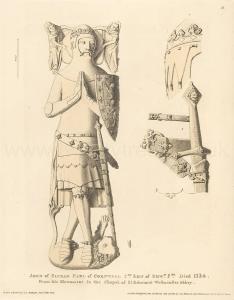
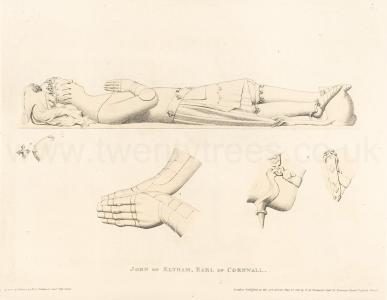
Effigy of Sir Hugh Calveley. The above are some few passages of the military career of this renowned English knight. He founded in 1386, the tenth year of the reign of Richard II a college at Rome, and at Bunbury [Map] in Cheshire. A story is extant, upon no certain foundation, that he married a Queen of Arragon. He might indeed while in Spain with the Black Prince have formed an alliance with some noble lady of the Spanish court. He reposes in an altar-tomb in Bunbury church, Cheshire [Map], which bears his eRigy as represented, and is surrounded by Gothic niches, intermixed with escutcheons.
Details. Plate 1. The effigy as originally painted. On the surcoat—the coat of Calveley, Argent, a fess Gules, between three calves Sable. Crest, a calf's head Sable. On the basinet is a rich circlet or wreath. The feet rest on a golden lion. Plate H. Profile. 1. Portion of the wreath on the basinet enlarged; also ornament of the rim of the basinet, with lace of the camail. 2. Girdle, chain suspending the sword, scabbard of the sword. 3. Mails of the hauberk and camail. 4. Part of the greave, solerette, spur, and ornamented strap.
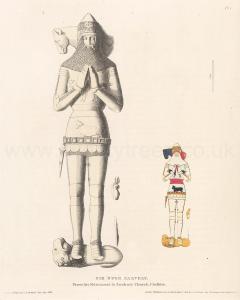
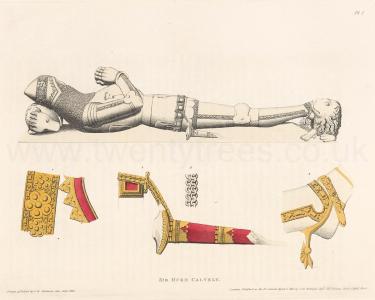
Around 1456 John Curzon (age 76) died. Monument in All Saints Church, Kedleston [Map] to John Curzon (age 76) and Joan Bagot (age 56). Fluted Period. Eagle Crest. Lancastrian Esses Collar. Couters. Pauldrons. Sabatons. Dogs chewing at her dress with Studded Collar. Probably Harpur and Moorecock of Burton on Trent.
John Curzon:
Around 1380 he was born to Richard Curzon at Kedleston.
Before 1412 John Curzon and Joan Bagot were married. The difference in their ages was 20 years.
Joan Bagot: Around 1400 she was born to John Bagot and Beatrice Mallory.

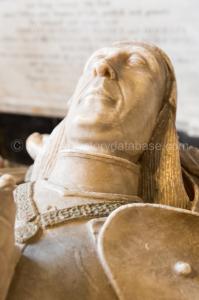
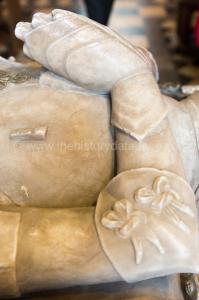
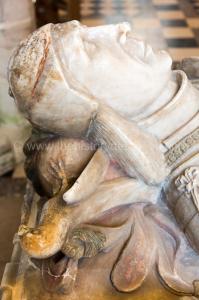
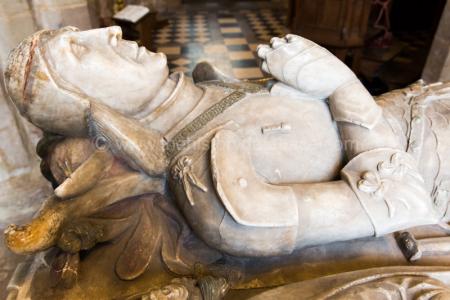
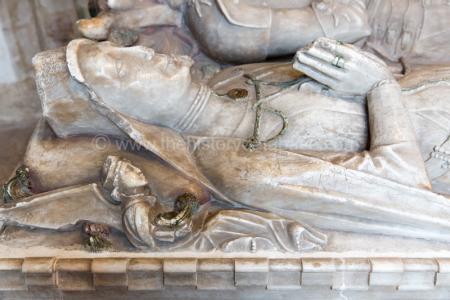
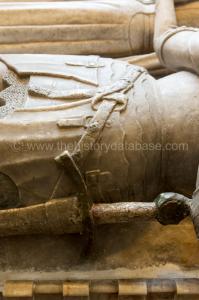
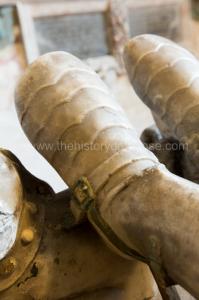
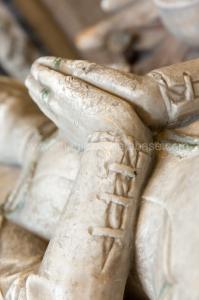
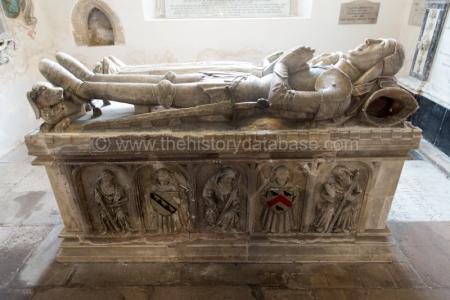
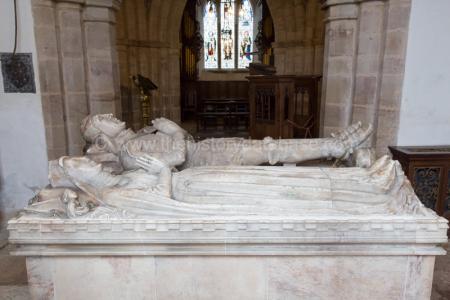
On 02 Mar 1484 Ralph Fitzherbert (age 56) died at Norbury, Derbyshire [Map]. He was buried at Church of St Barlok, Norbury [Map].
On 20 Oct 1490 Elizabeth Marshall (age 53) died. She was buried at Church of St Barlok, Norbury [Map].
Monument to Ralph and Elizabeth. Finely made in Chellaston alabaster of the Fluted Period. Possibly Harpur and Moorecock of Burton on Trent.
Ralph Fitzherbert: Ralph Fitzherbert and Elizabeth Marshall were married. Around 1428 he was born to Nicholas Fitzherbert and Alice Booth at Norbury, Derbyshire.
Elizabeth Marshall: Around 1437 she was born to John Marshall.
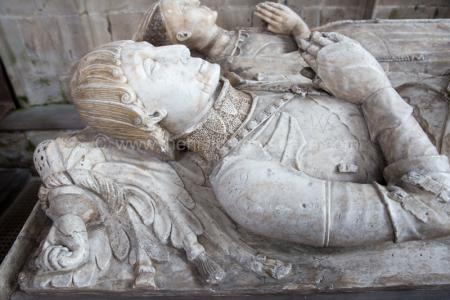 Bobbed hair with finely detailed ringlets. No facial hair. Suns and Roses Collar and the Fitzherbert Clenched Fist Crest.
Bobbed hair with finely detailed ringlets. No facial hair. Suns and Roses Collar and the Fitzherbert Clenched Fist Crest.
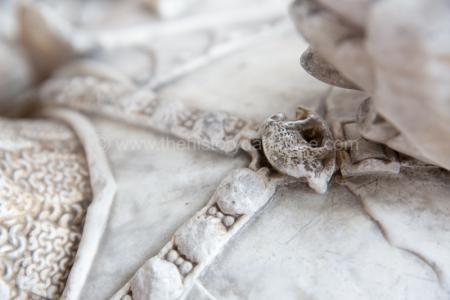 His effigy notable for being the only remaining with the Yorkist Boar Pendant (boar of Richard III) on his Suns and Roses Collar.
His effigy notable for being the only remaining with the Yorkist Boar Pendant (boar of Richard III) on his Suns and Roses Collar.
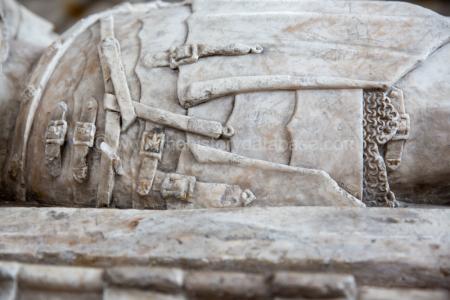
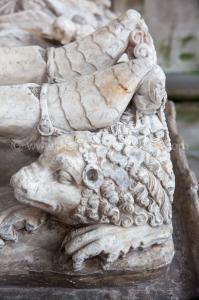
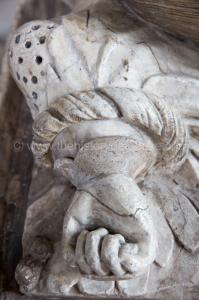
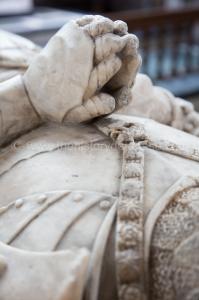
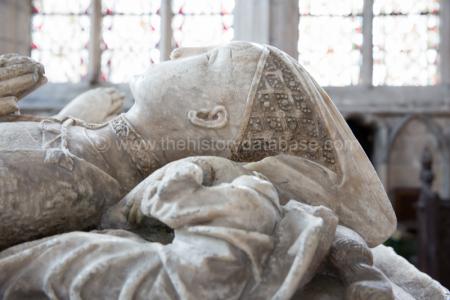 A finely carved Horned Headdress.
A finely carved Horned Headdress.
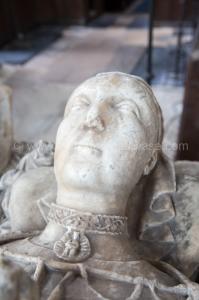 A finely carved collar with Mary and baby Jesus pendant.
A finely carved collar with Mary and baby Jesus pendant.
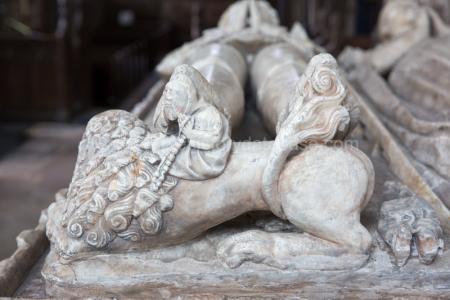 Fine Sabatons, the armoured feet, with spurs. Note the Bedesman, looking somewhat bored, under the right foot. Unlikely the sculptor had ever seen a lion. Feet resting on a Lion with Swirling Tail and Chunky Lions Mane.
Fine Sabatons, the armoured feet, with spurs. Note the Bedesman, looking somewhat bored, under the right foot. Unlikely the sculptor had ever seen a lion. Feet resting on a Lion with Swirling Tail and Chunky Lions Mane.
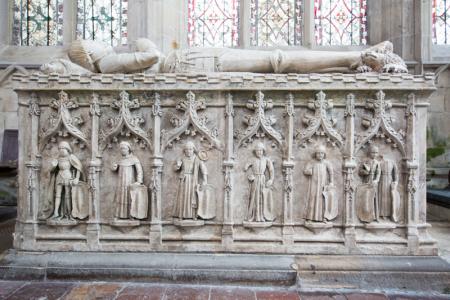 The chest finely made with weepers on the three extant sides. On one side five single men (a knight, a monk, two merchants and one unknown), and one couple. On the other side women, four single, two duos. Ralph and Elizabeth had twelve children, six male, six female so probable the weepers represent their children, possibly with spouses, possibly with offspring since in the two females duos there is a noticeable difference in height.
The chest finely made with weepers on the three extant sides. On one side five single men (a knight, a monk, two merchants and one unknown), and one couple. On the other side women, four single, two duos. Ralph and Elizabeth had twelve children, six male, six female so probable the weepers represent their children, possibly with spouses, possibly with offspring since in the two females duos there is a noticeable difference in height.
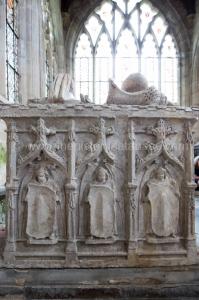
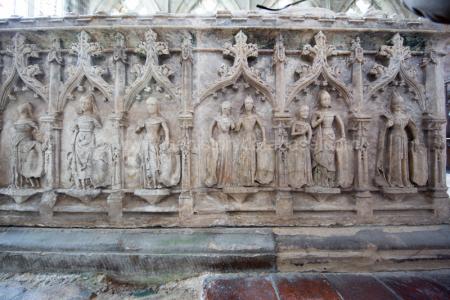 Excellent weepers on all sides, probably their issue, possibly with grandchildren, on the longer sides since they had six boys and six girls. Chest with Weepers holding Shields.
Excellent weepers on all sides, probably their issue, possibly with grandchildren, on the longer sides since they had six boys and six girls. Chest with Weepers holding Shields.
Effigy of John de la Pole, Duke of Suffolk, and his Duchess Elizabeth. JOHN was the son and heir of that unpopular minister, William de la Pole, Duke of Suffolk, who being banished for his political delinquencies, was put to death on the 2d May, 1450, at sea, off Dover, by the master of a Bristol shipa. His mother was Alice, daughter of Sir Thomas Chaucer, son of the poet of that name, the force of whose extraordinary genius has secured immortality for his works in spite of their obsolete language. He married Elizabeth, second daughter of Richard Duke of York, by whom he had five sons and four daughters; on account of which alliance his brother-in-law King Edward, in 1469, restored to him the dignity forfeited by his father's attainder. He was made Constable of Wallingford Castle, in the first year of the reign of Henry the Seventh, died in 1491, and was interred with his ancestors in the collegiate church at Wingfield [Map], in Suffolk. Elizabeth, his Duchess, was buried at the same place, and both are commemorated by the splendid effigies before us.



Details. Plate. I. Profile view of the head of the Duchess.
Plate II. 1. Portion of the Duke's coronet. 2. One of the metallic loops attaching the cordon of the mantle of the Garter to either shoulder. 3. Skirts of the corslet, hilt and guard of the sword, mountings of the scabbard, &c. 4. Portion of the Garter on the left knee, enlarged. 5. One of the straps attaching the tassets, 6. Hilt of the dagger, or misericorde, with lace attaching it to the hip. 7. The sword-belt. 8. Portion of the Duchess's coronet, enlarged. 9. Part of the metallic loop of the cordon of her mantle. 10. Pattern on the Ranches of her habit.
Plate III. 1. Profile view of the left genouiliiere, with the Garter. 2. Portion of the soles of the solerette, resting on the lion's mane.
Note a. Whatever the Duke's political offences, there is extant an admirable letter of advice from him to his son, John, written just before the Duke's departure on this fatal voyage. See the Paston Letters, vol. 1. p. 32; where also will be found, page 39, another curious letter, giving a circumstantial account of his death.
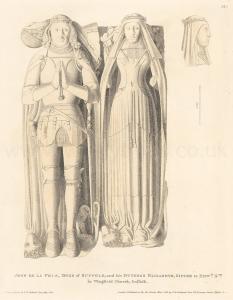
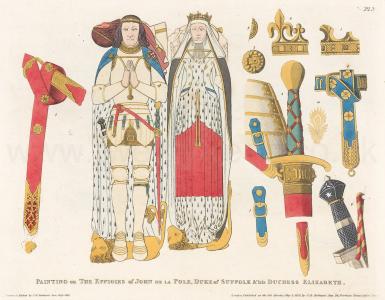
Effigy of Edward, the Black Prince. The Prince's Tomb is not in the Lady Chapel, as ordered in the Will, but on the south side of the Chapel of the Holy Trinity. In other respects it nearly agrees with the above order. The Tomb is of Sussex marble, divided into sixteen quatrefoiled panels, six on each side, two at the head, and two at the foot of the Tomb, in each of which are fixed escutcheons of copper, enamelled alternately with the arms and badges of the Black Prince. Above those, with the arms, is engraved on scrolls of copper, HOUMONT; and above those, with the badges in a similar manner, ICH DIENE. The effigy is of copper gilt, and lies upon the Tomb on a table of the same metal: it represents the Black Prince in armour, his head resting on his helmet, on which is the chapeau surmounted by a leopard crowned, having a file of three points about his neck. The countenance of the Prince possesses fine character. He is represented with long mustachios, which fall on each side over the camail, with which his face is closely enveloped; his beard is almost entirely concealed. On the bacinet is a rich coronet, the circle of which was once set with stones or glass. The manner of attaching the camail to the bacinet by the vervelles, or staples, with a silken lace, is here very clearly explaineda. The plates are very evident beneath the coat armour, which is emblazoned in relief with the arms of England and France quarterly, over all a file of three points. The gauntlets are armed with bosses or broches on the middle joints of the fingersb. The girdle is ornamented with gilt leopards' heads within circles, on a blue enamelled ground; in the centre within a quatrefoil, a leopard similarly enamelled. The sword is of the most beautiful workmanship. The pommel is ornamented with a leopard's head enamelled as the circles in the girdle. The hilt is of wirework. The sheath is richly wrought, engraved, and enamelled; its whole length is set with lapis lazuli in lozenges. The dagger is wanting. The solerets are of a preposterous length. It is uncertain what animal is intended at the feet. Considering how beautifully the whole of this figure is finished, it is singular that the armour is represented without either buckles, straps, or hinges. About the table of the Tomb are the inscriptions, engraved on plates of copper; the first is at the head of the Tomb, and the second commences on the south side and finishes on the north.
Note a. Pour six onces de soie de diverses couleurs a faire!es!as a mettre les camaux aus dits bacinets. Computum. Stepli. de la Fontaine, argentar. Reg. 1. Jan. 1349.
For six ounces of silk of various colours, to make laces to fasten the camails to the said bacinets.
Note b. In a Trial by Combat adjudged between John de Vesconti and Sir Thomas de la Marche, fought before Edward III in close Lists at Westminster; Sir Thomas de la Marche gained the advantage by striking the Rosses of Steel on his gauntlet, called Gadlings, into the face of his adversary.—Collin's Life of Edward Prince of Wales
Et riche bacinet li fist on apporter, [And on his bascinet his fist he brought?]
Caws a broches de fer, qui sont au redouter. [? haad iron pins, which are to be dreaded.]
MS. Bertrandi Guesclini.
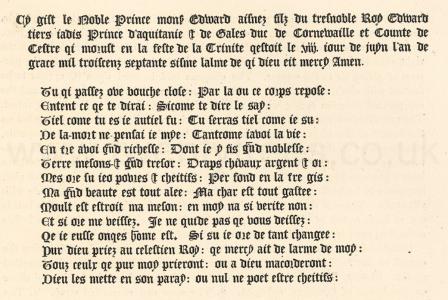
Effigy in Ash Church, Kent. St Nicholas Church, Ash.
ON the authority of Harris, this effigy may he assigned to Sir John Laverick. Weever, speaking of Ash, says, "in this church are many ancient monuments of worthy gentlemen, namely, Sir Goshalls and Sir Levericks, who lie crosse-legged as Knights of Jerusalema." There are many interesting points about the armour of this figure. The basinet and genouillieres are elegantly adorned with studs and leaves. The wrists of the gauntlets are composed of small laminae or splinters of plate.
Details. Plate I. 1. Ornament on the front of the basinet. 2. Buckle of the sword-belt. 3. Ornament on the bottom of the genouilliere. Plate II. Profile. 1. Lace of the camail, passing through scallops of plate, forming the lower part of the basinet. 2. Gauntlets. 3. Part of the solerette and jambe (near the ancle); portion of the spur, with straps. * Fun. Monuments, p.265.
Note a. Fun. Monuments, p.265.
